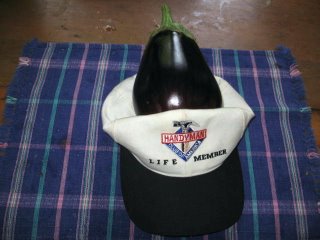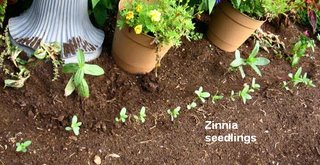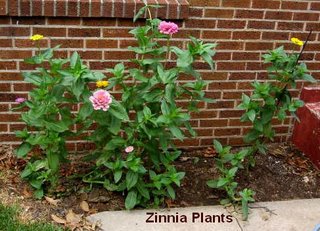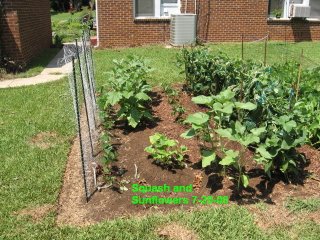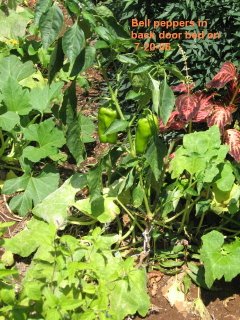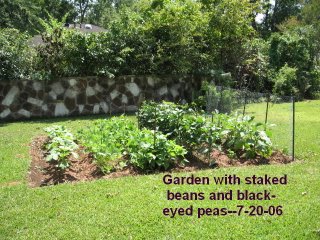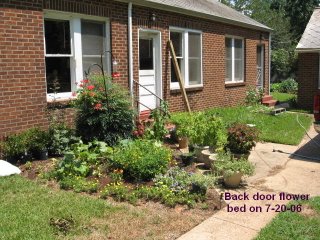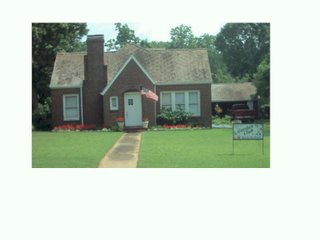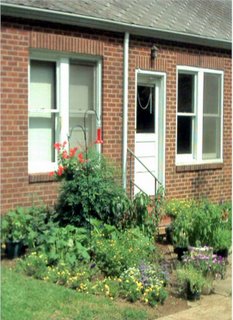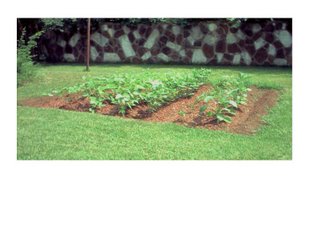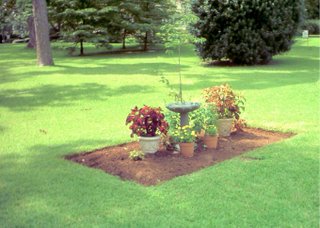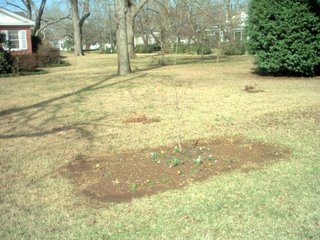I got up early this morning to mow the yard, but I only finished the front and side yards because it was 90 degrees (F) by 10:00AM. I didn't crank up the mower until almost 8:00 AM because it's Saturday and somebody was probably trying to sleep in. If they're still asleep at 8:00, then they stayed up too late and if they're that tired, they can probably sleep in spite of the noise. Anyway, it got too hot and I'll finish Monday.
I don't mow on Sunday. I'm old fashioned about keeping the day holy--or maybe, I just like to take a day off from physical labor at least one day a week; more than one day if I feel like it. Hey, I'm retired.
When I was growing up no one did chores on Sunday, at least not where anyone could see them. It was considered disgraceful to hang out washing (Nobody had driers then. I don't even think they had been invented except for commercial operations then ca. 1935 to 1954 +/-. The neighbors would talk if you even got out and swept the steps in front of the house. I can't remember when "blue laws" were repealed--some time in the sixties I think--but before then stores were never open on Sunday, except for "emergency" places like "filling" or "gas" stations on major highways. Neighborhood stations were all closed. That was when most people had two days off a week and women didn't usually work outside the home, except for widows and spinsters (spinster means and "old maid" stupid.)
I remember when petroleum companies stopped calling their retail outlets "filling" or "gas" stations too, and started insisting they were "service stations." That went by the boards with the first gas crunch in the seventies when "service" got to be an antique concept and everyone had to pump his own gas. Before that they wouldn't let you pump your own gas. Not only that, but back when "service" was still part of how they kept you as a customer, they'd check the oil and put air in the tires and wipe the windshield for you too. Finally filling your gas at a "service station" also became an quaint antique concept too and now you fill your own tank (and wipe your own windshield) at a "conveniene store," or a "retail outlet" if you're feeling real pissy. I suspect most people never check their oil now--or change it either. They just drive the sucker for a couple of years on the same oil and let the next owner (or the next) worry about the consequences. Few people check the air pressure in their tires either, which is one reason they don't get very good mileage--besides driving too fast. I plead guilty on the last count, so sue me.
Funny how the words "service" and "convenience" stopped applying to the customer and became the right of the merchant. Back when "service" stations stopped pumping gas for you, if you didn't pump your own gas you had to pay 3-4 cents for an "attendant" to fill your tank. "Filling your tank " was not the usual way to buy gas either back in the day. Nobody I knew had enough money to just pull in and "fill 'er up when I was a kid."

I don't remember Daddy ever filling up the car. He usually told the guy that pumped the gas: "Give me "5 gallons." Sometimes he'd put in 10 gallons if he was feeling flush or going on a trip. Gas was about .25 9/10 back then, so you were only talking about $2.00 to $2.50. I never remember Daddy getting less than 5 gallons however. It was just too much of a "white trash" thing to do. He certainly would never have pulled up and asked for 50 cents worth. That was really white trash. His picture, taken in about1940 is on the left. His name was William Bruce Harper and he was born February 23, 1908 in Jacksonville, Texas. He was a school teacher by profession and education, but he hated teaching school and got fired from his last school for cussing out the superintendent of schools, who happened to be his sister-in-law's husband. He was working as a ship fitter at the Todd Shipbuilding Company building Liberty ships during WW2 when he died of pneumonia on New Year's Day in 1945.
Anyway, back to mowing the yard. It takes about a tank of gas for the mower to cut the whole yard. I just emptied my first 2 gallon can and I've cut the yard maybe five times since I bought the mower, so it gets much better mileage than my Ford F-150 pickup truck. The pickup gets about 18 miles per gallon if I stay under 50 when I'm on the highway and about 15 if I drive 70, so I usually get about 14 miles per gallon.
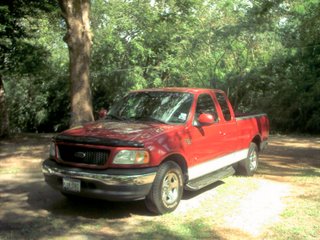
But what the dickens, the sucker is paid off. It's only got 88,000 miles on it (It's a 2001.) and will last me the rest of my life if I don't get in a wreck or something awful like that and don't live past 90 or so and can still drive without hitting the curbs too often.
I do think conservation is a good idea and I'm PC enough to worry about C02 and global warming--hey I had to stop mowing at 10:00AM because it got too hot. And, if I had to get a new vehicle, I'd try to find some kind of dual fuel or other "conservation" transportation. But I'm 70 and a pickup truck is a Texas icon and I still haul stuff for the garden, like mulch and plants and so forth, so driving the 2001 pickup is the best thing do to. If I got rid of it that doesn't mean it would be off the road anyway, so I might as well keep on driving it myself (and BTW changing the oil, getting regular tune-ups, and checking the air in the tires too.) I take care of myself too; regular check-ups and good dental care. I've still got all my original body parts in reasonable good operating condition too, including teeth.
Speaking of mulch before I got of on talking about teeth, I got a palletload of pine barck mulch from a fellow down in Pineville about 12 miles south of here on State Highway 147. It wasn't necessarily cheaper than buying the stuff from WalMart, but it's from local trees and if it's got bark beetles or something like that, at least they're local pests and not from some God-forsaken foreign trees with Lord only knows what kind of infestations.
That's enough for now. Tomorrow is church and I've got to start thinking about a sermon. You can check to see what I said at www.christchurchsatx.blogspot.com if you're really hard up for a holiness infusion, but don't expect me to get the sermon up until about Wednesday or Thursday.
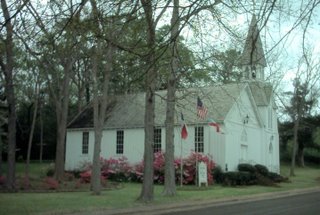
BTW there's a link on in the right hand column to the church web site as well as the blog
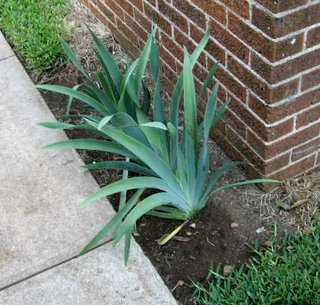 A year or so ago, I dug up and brought home some iris rhizomes I found growing on the grave of my gggrandfather in a long-neglected cemetery in East Texas and planted them in a container when I lived in New Orleans. When they bloomed they were a dingy white that looked like they may have been violet or pink at some time in the past and had faded while they were growing in the wild. I revisited the cemetery recently and dug up a few more to plant in Glynn's Farm. I wrote to Schreiner's gardens in Oregon to ask for information on my "wild" iris and received the following email from Tom Abrego at Schreiner's Gardens. He writes:
A year or so ago, I dug up and brought home some iris rhizomes I found growing on the grave of my gggrandfather in a long-neglected cemetery in East Texas and planted them in a container when I lived in New Orleans. When they bloomed they were a dingy white that looked like they may have been violet or pink at some time in the past and had faded while they were growing in the wild. I revisited the cemetery recently and dug up a few more to plant in Glynn's Farm. I wrote to Schreiner's gardens in Oregon to ask for information on my "wild" iris and received the following email from Tom Abrego at Schreiner's Gardens. He writes: